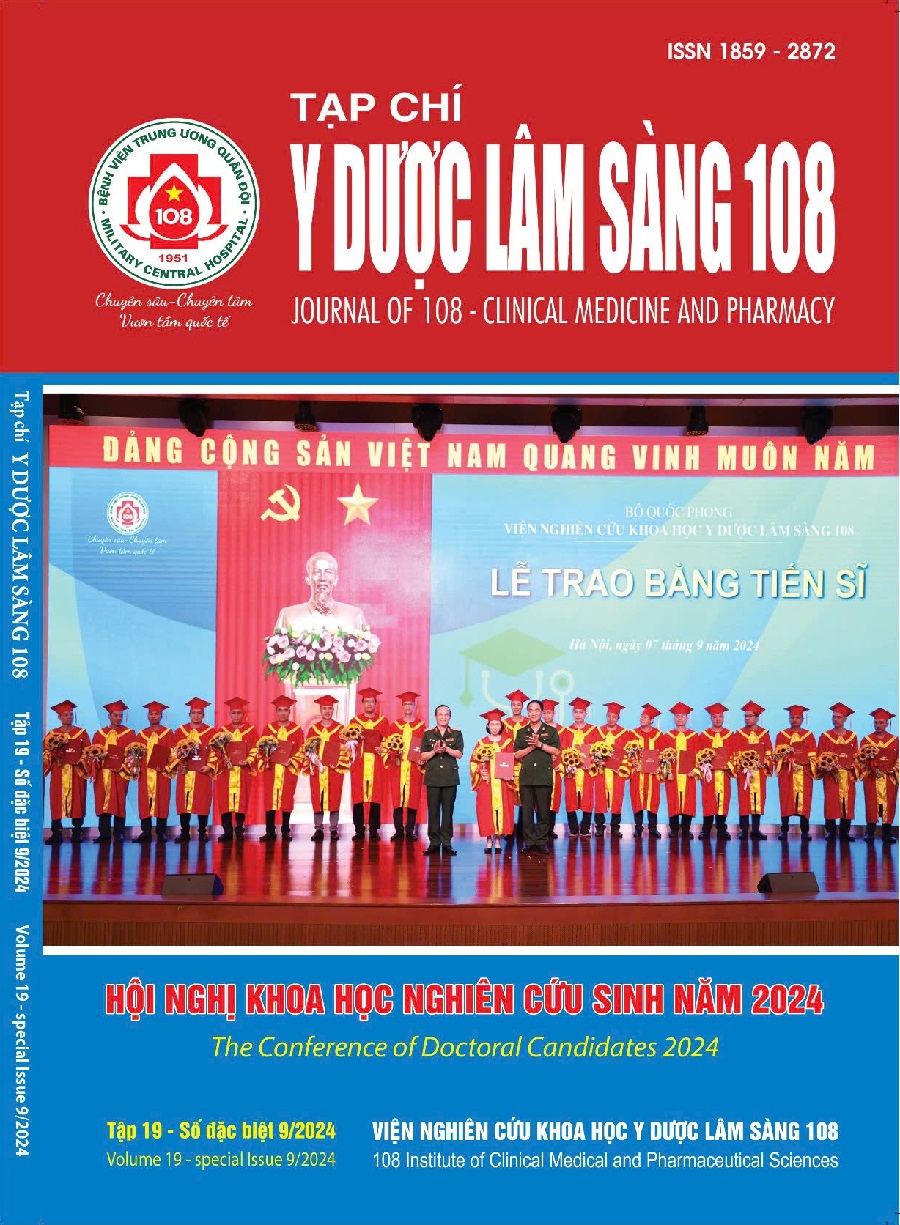Preliminary evaluation of the effectiveness and safety of emergency flow-diverting stent and coiling for treating ruptured cerebral aneurysms at the 108 Military Central Hospital
Main Article Content
Keywords
Abstract
Objective: To evaluate the morphological characteristics of ruptured cerebral aneurysms and the effectiveness and safety of emergency treatment using flow-diverting stents combined with coil embolization. Subject and method: A retrospective study was conducted on 16 patients with 16 aneurysms causing subarachnoid hemorrhage, treated by flow-diverting stenting combine with coiling from January 2022 to May 2024. Result: Saccular aneurysms accounted for 43.75%, blister-like aneurysms for 50.00%, and fusiform aneurysms for 6.25%. The average size of the aneurysms was 6.17 ± 5.21mm, with a dome-to-neck ratio < 1.5 in 50.00% of cases. Aneurysms located in the anterior circulation accounted for 87.50%. The technique of using flow-diverting stents combined with coil embolization was successfully performed in 100% of patients. Immediately after intervention, 56.25% of the aneurysms were completely occluded, and 100% were completely occluded after one month. No technique-related complications were recorded, with an overall complication rate of 12.5%. There was one fatality due to re-rupture immediately after intervention, accounting for 6.25%. After one month, the surviving patients nearly fully recovered, with an mRS = 0 in 14 out of 15 cases, and one case with a mild sequela after three months with mRS = 1. Conclusion: Emergency intervention with flow-diverting stents combined with coil embolization for the treatment of ruptured cerebral aneurysms is highly safe and effective.
Article Details
References
2. Raymond J, Klink R, Chagnon M, Barnwell SL, Evans AJ, Mocco J, Hoh BH, Turk AS, Turner RD, Desal H, Fiorella D, Bracard S, Weill A, Guilbert F, Lanthier S, Fox AJ, Darsaut TE, White PM, Roy D (2017) Hydrogel versus Bare platinum coils in patients with large or recurrent aneurysms prone to recurrence after endovascular treatment: A randomized controlled trial. AJNR Am J Neuroradiol 38(3): 432-441.
3. Natarajan SK, Shallwani H, Fennell VS, Beecher JS, Shakir HJ, Davies JM, Snyder KV, Siddiqui AH, Levy EI (2017) Flow diversion after aneurysmal subarachnoid hemorrhage. Neurosurg Clin N Am 28(3): 375-388.
4. Cagnazzo F, di Carlo DT, Cappucci M, Lefevre PH, Costalat V, Perrini P (2018) Acutely ruptured intracranial aneurysms treated with flow-diverter stents: A systematic review and meta-analysis. AJNR Am J Neuroradiol 39(9): 1669-1675.
5. Mascitelli JR, Moyle H, Oermann EK, Polykarpou MF, Patel AA, Doshi AH, Gologorsky Y, Bederson JB, Patel AB (2015) An update to the Raymond-Roy Occlusion Classification of intracranial aneurysms treated with coil embolization. J Neurointerv Surg 7(7): 496-502.
6. Jersey AM and Foster DM (2024) Cerebral Aneurysm, in StatPearls. 2024: Treasure Island (FL) ineligible companies. Disclosure: David Foster declares no relevant financial relationships with ineligible companies.
7. Abe M, Tabuchi K, Yokoyama H, Uchino A (1998) Blood blisterlike aneurysms of the internal carotid artery. J Neurosurg 89(3): 419-424.
8. Kalani MY, Zabramski JM, Kim LJ, Chowdhry SA, Mendes GA, Nakaji P, McDougall CG, Albuquerque FC, Spetzler RF (2013) Long-term follow-up of blister aneurysms of the internal carotid artery. Neurosurgery 73(6): 1026-1033; discussion 1033.
9. Sebastian Sanchez M, Meredith Hickerson, Rishi R Patel, Dana Ghazaleh, Ranita Tarchand, Geeta S. Paranjape, Holly Pope, Santiago Ortega‐Gutierrez, John M Pederson, David Hasan, Madhavan L Raghavan, and Edgar A Samaniego (2023) Morphological characteristics of ruptured brain aneurysms: A systematic literature review and meta‐analysis. Stroke: Vascular and Interventional Neurology.
10. Agarwal A, Gokhale S, Gupta J, Raju R, Nimjee S, Smith T, Britz GW (2014) Use of pipeline flow diverting stents for wide neck intracranial aneurysms: A retrospective institutional review. Asian J Neurosurg 9(1): 3-6.
11. Foreman PM, Ilyas A, Cress MC, Vachhani JA, Hirschl RA, Agee B, Griessenauer CJ (2021) Ruptured intracranial aneurysms treated with the pipeline embolization device: A systematic review and pooled analysis of individual patient data. AJNR Am J Neuroradiol 42(4): 720-725.
12. Guimaraens L, Vivas E, Saldaña J, Llibre JC, Gil A, Balaguer E, Rodríguez-Campello A, Cuadrado-Godia E, Ois A (2020) Efficacy and safety of the dual-layer flow-diverting stent (FRED) for the treatment of intracranial aneurysms. J Neurointerv Surg 12(5): 521-525.
13. Zhong W, Kuang H, Zhang P, Yang X, Luo B, Maimaitili A, Zhao Y, Song D, Guan S, Zhang H, Wang Y, Wang D, Su W, Wang Y (2021) Pipeline embolization device for the treatment of ruptured intracerebral aneurysms: A multicenter retrospective study. Front Neurol 12: 675917.
14. Cohen JE, Gomori JM, Moscovici S, Kaye AH, Shoshan Y, Spektor S, Leker RR (2021) Flow-diverter stents in the early management of acutely ruptured brain aneurysms: Effective rebleeding protection with low thromboembolic complications. J Neurosurg: 1-8.
 ISSN: 1859 - 2872
ISSN: 1859 - 2872
